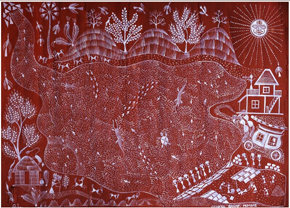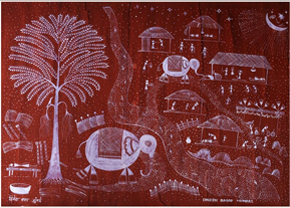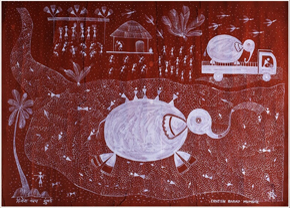GALLERY 02 | WATER & CULTURE
EXHIBIT 03/03 04
Water and Communities
Explore the sub exhibits
Amongst the original inhabitants of Mumbai, they live in relative harmony with nature along the pristine rivers that emerge from this part of the city. Dinesh Barap, a young member of the Warli community, is the lone torchbearer of the Warli art in the Sanjay Gandhi National Park.
Through his paintings, Dinesh takes us down memory lane to stories from his childhood spent around the Dahisar River with his grandmother, from whom he also inherited the legacy of Warli art.
मुंबईच्या मूळ रहिवाशांपैकी एक असलेला हा आदिवासी समाज इथेच उगम पावलेल्या नदी काठी निसर्गाशी एकरूप होऊन वास्तव्य करत आहे. संजय गांधी राष्ट्रीय उद्यानातील वारली तरुण, दिनेश बारप, आज एकहाती वारली कलेची धुरा वाहत आहे.
दिनेशला वारली चित्रकलेचा वारसा त्याच्या आजी कडून मिळाला. त्याच्या आजीबरोबर दहिसर नदी काठी घालविलेल्या बालपणाची सफर तो या चित्रांतून घडवतो.
WARLI FOLKTALES
Warli artist Dinesh Barap takes us down memory lane through a set of 6 paintings that narrate 3 stories of childhood folktales and incidents along the waters of Tulsi Lake and Dahisar River that he grew up around.

HOW TULSI LAKE GOT ITS NAME
This story is a piece from Dinesh’s childhood memories; a local legend that he has heard from his grandmother. It narrates an eerie tale of a lone fisherwoman, who lived around a lake in the forest. After her death, unexplained accidents around a dam project (started at the behest of the British) lead to a mystical experience in which the fisherwoman commands that the lake and dam be named after her. It is widely believed by the Wwarlis that is how Tulsi Lake got its name.


THE ELEPHANT NAMED RANI
This story narrates a warm and heart wrenching memory that Dinesh has of an elephant called Rani who took refuge in the forest to escape from the legal system which did not allow elephant rides in the city. Drawn to the Wwarlis in the forest for food and play, Rani ends up becoming the children’s favourite playmate, frolicking with them in the river till she is finally located and taken captive
by the forest rangers.


JOURNEY OF MAN TO EARTH
A quintessential folk tale narrated by Dinesh’s grandmother, this story holds an important place in his memories. Here he depicts a scenario where various forms of creation were made from the wind blown out of the tarpa (a traditional Wwarli musical instrument made out of a bottle gourd). Humans were sent down to the earth floating on the waters in a tarpa and settled on the coast of an island. The rest of the planet was essentially water and the god of creation took a tour of the earth on the back of his peacock.

